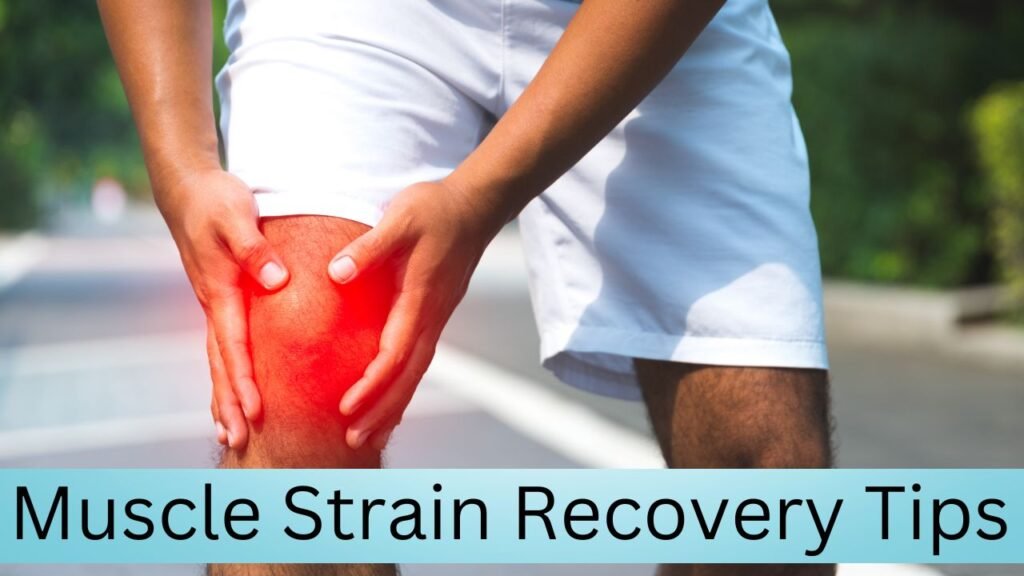Muscle strains are common injuries that can happen during exercise, sports, or everyday activities. A strained muscle occurs when fibers tear due to excessive stretching or overuse. While most cases heal with proper care, knowing the right recovery strategies can speed up the healing process and prevent future injuries.
Understanding Muscle Strains
Muscle strains vary in severity, ranging from mild discomfort to severe pain and limited mobility. They are classified into three grades:
- Grade 1: Mild strain with minimal damage and slight discomfort.
- Grade 2: Moderate strain with partial muscle tear and noticeable weakness.
- Grade 3: Severe strain involving a complete muscle tear, often requiring medical attention.
Common symptoms include pain, swelling, bruising, and muscle weakness. Understanding the level of strain helps in determining the best recovery approach.

Immediate Steps for Muscle Strain Recovery
Proper care in the initial stages prevents further damage and sets the foundation for faster healing. Follow these essential steps:
1. Follow the RICE Method
The RICE method is a proven approach for managing muscle injuries:
- Rest: Avoid activities that put stress on the strained muscle.
- Ice: Apply ice packs for 15-20 minutes every few hours to reduce swelling.
- Compression: Use a bandage or wrap to minimize inflammation.
- Elevation: Keep the injured area elevated to improve blood circulation and reduce swelling.
2. Avoid Stretching Too Soon
Stretching a strained muscle too early can worsen the injury. Give the muscle time to heal before resuming flexibility exercises.
3. Use Over-the-Counter Pain Relievers
Nonsteroidal anti-inflammatory drugs (NSAIDs) like ibuprofen or naproxen can help manage pain and swelling. However, they should be used in moderation and according to medical advice.
Strategies to Speed Up Muscle Healing
After the initial phase, incorporating targeted recovery techniques accelerates muscle repair and restores function.
1. Gradual Movement and Gentle Exercises
Once pain subsides, light movement prevents stiffness and promotes healing. Try:
- Low-impact activities like walking or swimming.
- Isometric exercises to maintain muscle engagement without excessive strain.
- Range-of-motion movements to restore flexibility.
2. Proper Nutrition for Muscle Repair
The body needs essential nutrients to rebuild muscle fibers. Focus on:
- Protein: Supports tissue repair (lean meats, eggs, dairy, legumes).
- Omega-3 Fatty Acids: Reduce inflammation (salmon, walnuts, flaxseeds).
- Vitamin C: Aids collagen formation (citrus fruits, bell peppers, strawberries).
- Magnesium: Helps muscle relaxation and recovery (nuts, spinach, whole grains).
3. Hydration for Muscle Function
Dehydration impairs muscle recovery. Drink plenty of water and consume electrolyte-rich fluids to maintain optimal muscle function.
4. Massage and Foam Rolling
Gentle massage increases blood flow and reduces muscle tightness. Foam rolling can break up adhesions and improve flexibility.
5. Heat Therapy for Relaxation
After the initial inflammation subsides, applying heat improves circulation and relieves muscle stiffness. Use warm compresses or take a warm bath to ease tension.
Preventing Future Muscle Strains
Reducing the risk of future strains is crucial for long-term muscle health. Follow these preventive measures:
1. Warm Up Before Exercise
A proper warm-up prepares muscles for activity and reduces the chance of injury. Dynamic stretches and light cardio improve blood flow and flexibility.
2. Strengthen Supporting Muscles
Weak muscles are more prone to strain. Strength training enhances stability and resilience, reducing the likelihood of injury.
3. Improve Flexibility
Regular stretching maintains muscle elasticity and prevents stiffness. Focus on dynamic stretching before workouts and static stretching after.
4. Maintain Good Posture
Poor posture puts unnecessary stress on muscles. Whether sitting, standing, or lifting, ensure proper alignment to avoid unnecessary strain.
5. Avoid Overtraining
Overworking muscles without adequate rest increases injury risk. Incorporate rest days and listen to your body’s signals to prevent excessive fatigue.
6. Wear Proper Footwear
Supportive shoes provide stability and reduce strain on muscles and joints, especially during physical activity.
When to Seek Medical Attention
Most muscle strains heal within a few weeks, but medical intervention may be necessary in severe cases. See a doctor if:
- Pain is intense and doesn’t improve with rest.
- There is significant swelling or bruising.
- You cannot move the affected muscle.
- You hear a popping sound at the time of injury.
Conclusion
Recovering from a muscle strain requires patience and the right approach. Rest, nutrition, and gentle movement play key roles in healing. By following proper recovery techniques and taking preventive measures, you can reduce downtime and keep muscles strong and healthy. If symptoms persist, consult a healthcare professional for personalized guidance.